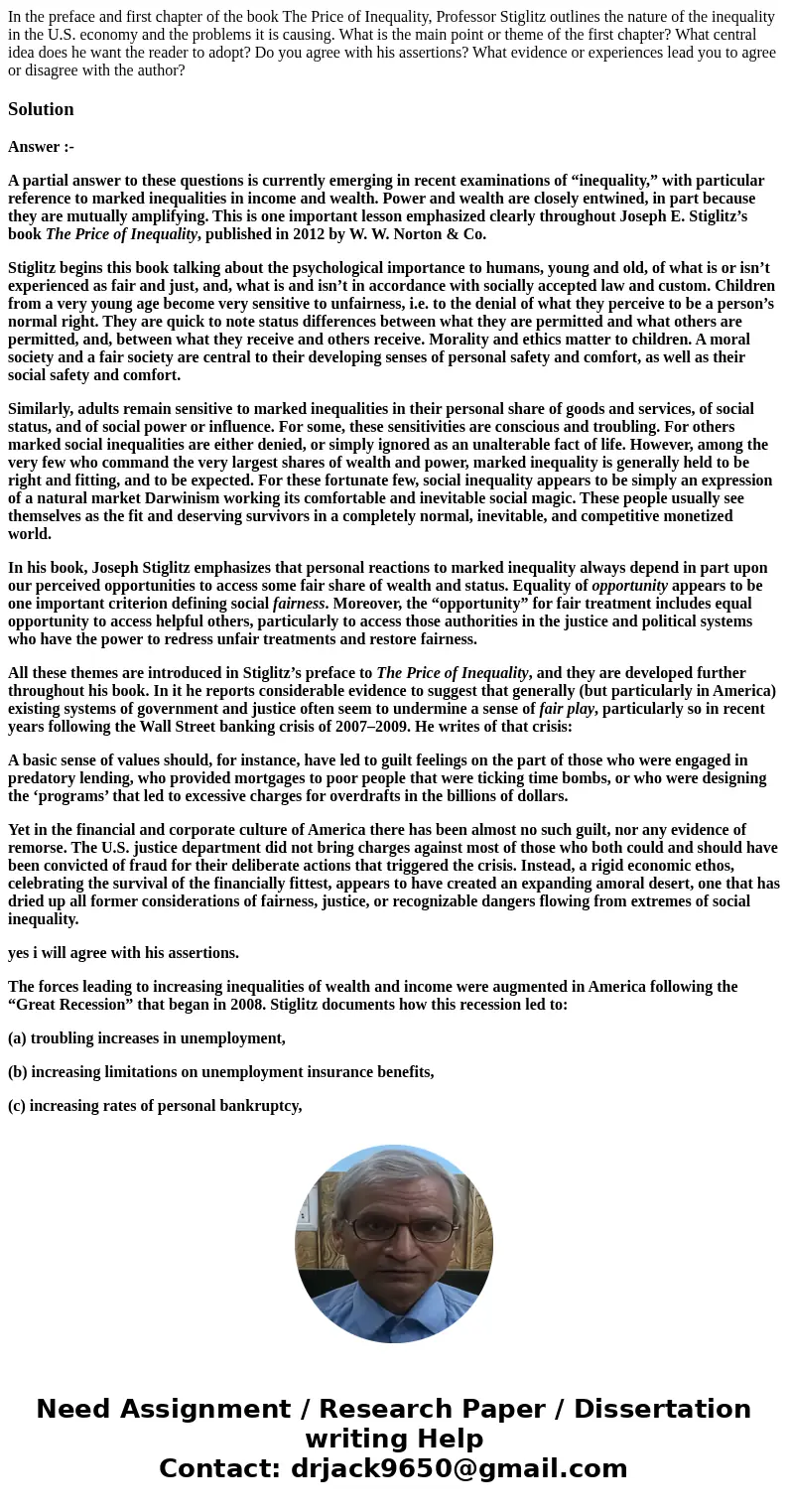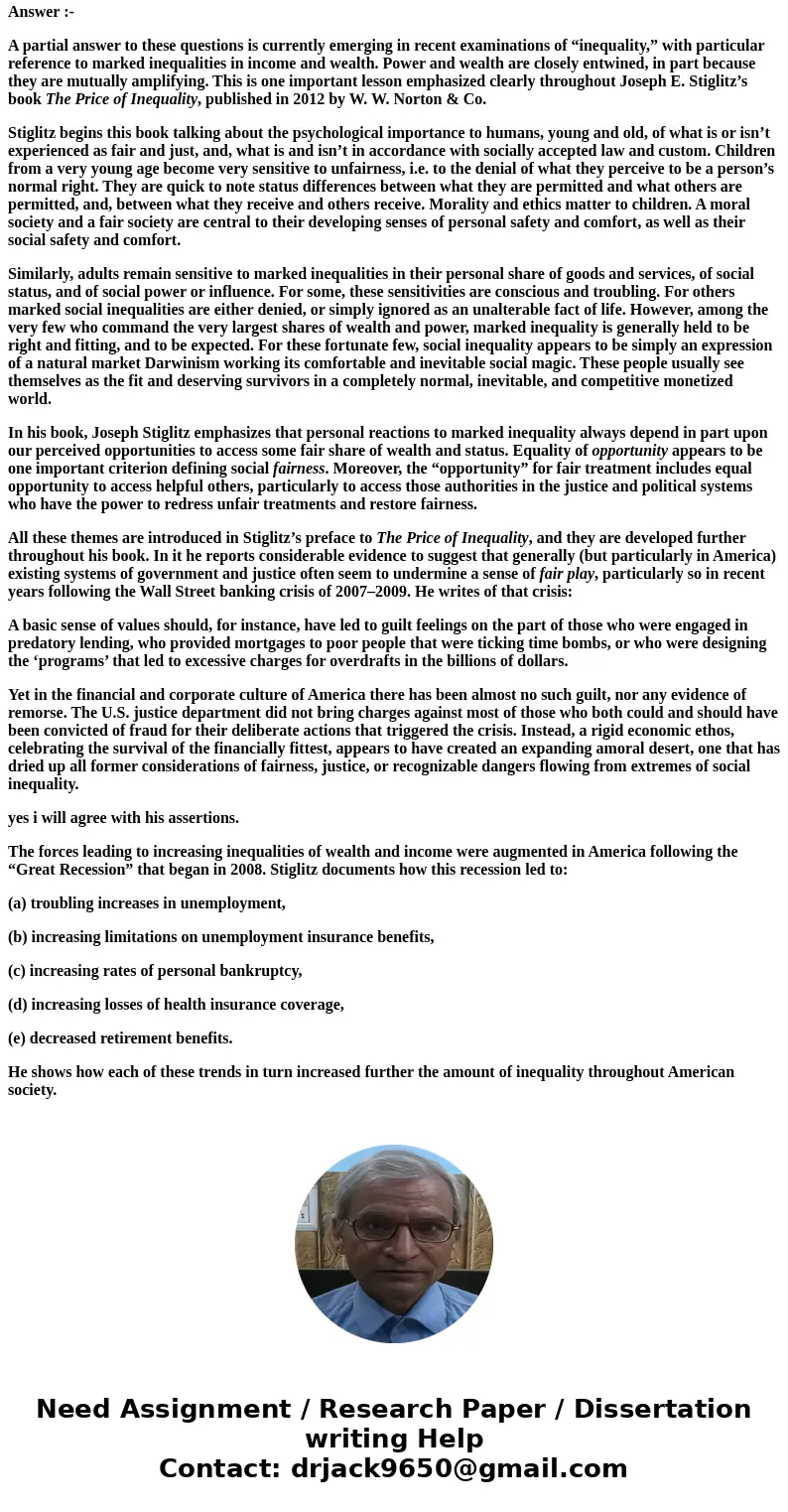In the preface and first chapter of the book The Price of In
In the preface and first chapter of the book The Price of Inequality, Professor Stiglitz outlines the nature of the inequality in the U.S. economy and the problems it is causing. What is the main point or theme of the first chapter? What central idea does he want the reader to adopt? Do you agree with his assertions? What evidence or experiences lead you to agree or disagree with the author?
Solution
Answer :-
A partial answer to these questions is currently emerging in recent examinations of “inequality,” with particular reference to marked inequalities in income and wealth. Power and wealth are closely entwined, in part because they are mutually amplifying. This is one important lesson emphasized clearly throughout Joseph E. Stiglitz’s book The Price of Inequality, published in 2012 by W. W. Norton & Co.
Stiglitz begins this book talking about the psychological importance to humans, young and old, of what is or isn’t experienced as fair and just, and, what is and isn’t in accordance with socially accepted law and custom. Children from a very young age become very sensitive to unfairness, i.e. to the denial of what they perceive to be a person’s normal right. They are quick to note status differences between what they are permitted and what others are permitted, and, between what they receive and others receive. Morality and ethics matter to children. A moral society and a fair society are central to their developing senses of personal safety and comfort, as well as their social safety and comfort.
Similarly, adults remain sensitive to marked inequalities in their personal share of goods and services, of social status, and of social power or influence. For some, these sensitivities are conscious and troubling. For others marked social inequalities are either denied, or simply ignored as an unalterable fact of life. However, among the very few who command the very largest shares of wealth and power, marked inequality is generally held to be right and fitting, and to be expected. For these fortunate few, social inequality appears to be simply an expression of a natural market Darwinism working its comfortable and inevitable social magic. These people usually see themselves as the fit and deserving survivors in a completely normal, inevitable, and competitive monetized world.
In his book, Joseph Stiglitz emphasizes that personal reactions to marked inequality always depend in part upon our perceived opportunities to access some fair share of wealth and status. Equality of opportunity appears to be one important criterion defining social fairness. Moreover, the “opportunity” for fair treatment includes equal opportunity to access helpful others, particularly to access those authorities in the justice and political systems who have the power to redress unfair treatments and restore fairness.
All these themes are introduced in Stiglitz’s preface to The Price of Inequality, and they are developed further throughout his book. In it he reports considerable evidence to suggest that generally (but particularly in America) existing systems of government and justice often seem to undermine a sense of fair play, particularly so in recent years following the Wall Street banking crisis of 2007–2009. He writes of that crisis:
A basic sense of values should, for instance, have led to guilt feelings on the part of those who were engaged in predatory lending, who provided mortgages to poor people that were ticking time bombs, or who were designing the ‘programs’ that led to excessive charges for overdrafts in the billions of dollars.
Yet in the financial and corporate culture of America there has been almost no such guilt, nor any evidence of remorse. The U.S. justice department did not bring charges against most of those who both could and should have been convicted of fraud for their deliberate actions that triggered the crisis. Instead, a rigid economic ethos, celebrating the survival of the financially fittest, appears to have created an expanding amoral desert, one that has dried up all former considerations of fairness, justice, or recognizable dangers flowing from extremes of social inequality.
yes i will agree with his assertions.
The forces leading to increasing inequalities of wealth and income were augmented in America following the “Great Recession” that began in 2008. Stiglitz documents how this recession led to:
(a) troubling increases in unemployment,
(b) increasing limitations on unemployment insurance benefits,
(c) increasing rates of personal bankruptcy,
(d) increasing losses of health insurance coverage,
(e) decreased retirement benefits.
He shows how each of these trends in turn increased further the amount of inequality throughout American society.


 Homework Sourse
Homework Sourse